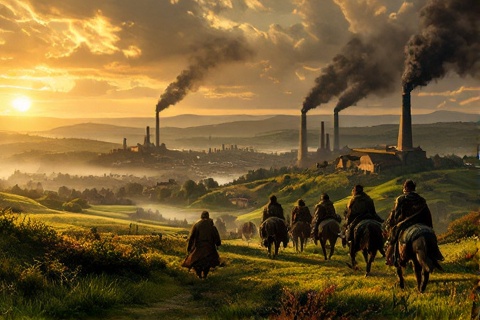
The Scouring of the Shire
Hobbits Reclaim Their Home
Return of the Travelers
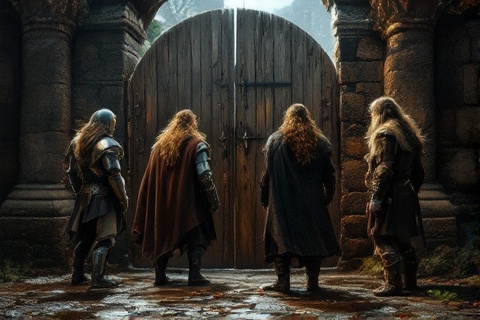
On October 30, 3019 of the Third Age, Frodo, Sam, Merry, and Pippin finally
reached the borders of their beloved Shire after their long journey and the
completion of the Quest of the Ring. Their joy at returning home was quickly
tempered by the strange and unwelcoming sight that greeted them at the
Brandywine Bridge, where they discovered a large gate barring their way with
signs posting rules and restrictions. The hobbits found the
gate guarded by men who attempted to enforce a curfew, though they were no match
for the returning travelers' newfound confidence and authority.
When confronted with the hostile gatekeepers at the Brandywine Bridge, the
hobbits encountered their first taste of the changed Shire, where armed men
prevented free movement of hobbits after nightfall. The guards, unused to
resistance, were particularly startled by the official documents from the King
of Arnor and Gondor that the travelers carried,
showing how disconnected the Shire had become from the great events of
Middle-earth.
The military training and experience that Merry and Pippin gained during their
adventures proved immediately valuable upon their return. Merry's experience as
a Knight of Rohan and Pippin's service as a Guard of the Citadel of Gondor had
given them both the confidence and tactical knowledge to handle the
confrontation at the gate. Their commanding presence and understanding of
authority helped them take control of the situation, demonstrating how much they
had grown from the carefree hobbits who had left the Shire a year before.
The Changed Shire
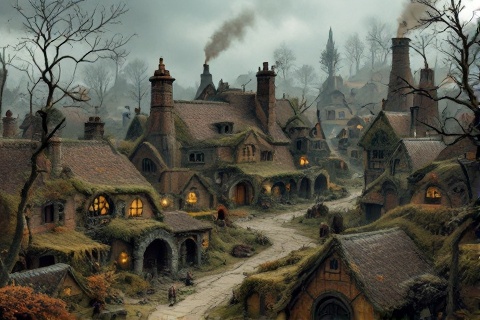
Under the regime of the mysterious figure known only as 'The Chief,' the Shire
had fallen under a system of oppressive rules and restrictions that went against
every aspect of traditional hobbit life. New regulations controlled everything
from farming practices to the gathering of people, with written permits required
for the most basic activities. The Chief's Men, as they called
themselves, enforced these rules with threatening behavior and harsh
punishments.
One of the most visible and heartbreaking changes to the Shire was the
widespread destruction of its natural beauty, particularly its beloved trees.
The old Party Tree in Hobbiton had been cut down, and many of the Shire's
ancient woodlands had been felled to feed the new mills and factories. These
ugly new buildings belched smoke into the once-clean air of the Shire, replacing
the traditional hobbit-holes and cottages with industrial monstrosities.
The hobbits of the Shire found themselves living under conditions they had never
before experienced, with strict rationing of food and other essentials despite
the land's natural abundance. Families who had never known want were now going
hungry, while their produce and goods were being 'gathered' and 'shared out' by
the Chief's Men, though little ever seemed to be shared back to the rightful
owners. The once-prosperous and well-fed hobbits were reduced to a state of fear
and scarcity.
The social heart of hobbit society had been torn apart by the new regime, with
beloved institutions like the inns and taverns being closed down or converted to
storage houses for the Chief's Men. Many hobbits had been forced to abandon
their comfortable homes, particularly those living in desirable properties, and
were crowded into shared housing while their own dwellings were taken over by
the ruffians. The Green Dragon and other famous establishments stood empty and
dark, their doors locked and windows boarded.
Sharkey's Men
The Shire had fallen under the control of a band of ruffians and brigands who
maintained their power through a combination of intimidation, violence, and the
exploitation of hobbit tendencies toward avoiding confrontation. These Men,
mostly from the South, had established a network of informants and bullies
throughout the Shire, making it difficult for hobbits to organize any resistance
without fear of reprisal.
The true identity of 'The Chief' was revealed to be none other than Saruman
himself, now calling himself 'Sharkey' in the Shire. The fallen wizard, once the
head of the White Council and master of Isengard, had sought revenge for his
defeat by destroying the homeland of the hobbits who had helped bring about his
downfall. His presence in the Shire represented the last gasp of the evil that
had threatened Middle-earth during the War of the Ring.
As word spread of the returning heroes and their stand against the ruffians,
hobbits throughout the Shire began to gather in resistance to their oppressors.
The natural courage of hobbits, though long suppressed by the bullying tactics
of the Chief's Men, began to resurface as they saw the example set by Frodo,
Sam, Merry, and Pippin. The returning travelers' tales of their deeds in the
outside world inspired their fellow hobbits to stand up against tyranny.
The Battle of Bywater
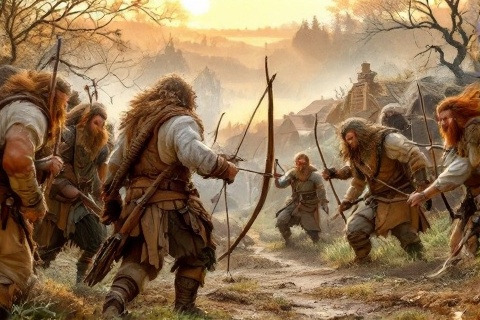
The Battle of Bywater, which took place on November
3, 3019, became the largest and most significant battle fought in the Shire
since the Battle of Greenfields in 2747 of the Third Age. The conflict began
when nearly a hundred ruffians came to Bywater to put down what they thought
would be a simple hobbit rebellion, but instead found themselves facing an
organized and determined resistance. The battle demonstrated that hobbits, when
pushed to defend their homes, could be formidable fighters.
Merry and Pippin took charge of organizing the hobbit resistance, applying the
military tactics they had learned in Rohan and Gondor. They arranged the hobbits
into groups, set up defensive positions, and planned a strategy that would use
the local terrain and hobbit characteristics to their advantage. Their
leadership transformed what might have been a disorganized rebellion into a
decisive military victory.
The battle proved costly for both sides, with seventy of the ruffians killed and
twelve hobbits losing their lives in defense of their homeland. The losses were
deeply felt by the peace-loving hobbits, but the victory was complete. The
remaining ruffians surrendered or fled, marking the beginning of the end for
Sharkey's regime in the Shire.
Saruman's Last Stand
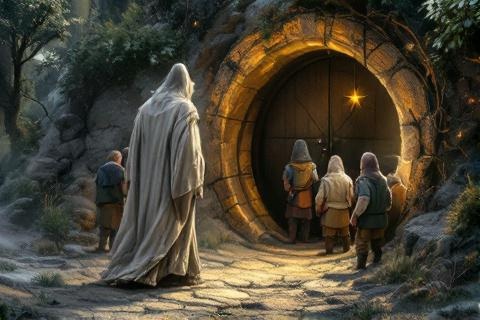
The final confrontation with Saruman took place at Bag End, which the fallen
wizard had made his personal headquarters during his occupation of the Shire.
The once-beautiful hobbit-hole had been transformed into a shabby and neglected
dwelling, reflecting the corruption of its occupant. When confronted by the
returning hobbits and their allies, Saruman revealed the full extent of his
bitterness and malice.
Despite Saruman's attempts to kill Frodo and his cruel actions against the
Shire, Frodo showed remarkable mercy toward his defeated enemy. Drawing on his
own experiences with the corrupting influence of power, Frodo understood that
revenge would only perpetuate the cycle of violence. His compassion stood in
stark contrast to Saruman's spite and malice.
The end came swiftly when Gríma Wormtongue,
Saruman's long-suffering servant, finally broke under his master's cruelty and
mockery. In a moment of violent rebellion, Wormtongue cut Saruman's throat
before being brought down himself by hobbit arrows. The death of the former head
of the White Council marked the true end of the War of the Ring, as the last
remnant of Sauron's influence in Middle-earth was
extinguished.
The Restoration Begins

Samwise Gamgee, using the precious box of soil given to him by the Lady
Galadriel in Lothlórien, began the
work of healing the Shire's wounded landscape. The gift contained a single
silver nut from Galadriel's garden, along with the blessed soil of her realm,
which Sam used to plant new trees throughout the Shire. Where the magnificent
Party Tree had stood, he planted a mallorn seed, bringing a piece of
Elven beauty to the heart of the Shire.
The hobbits worked together to tear down the ugly new buildings and mills that
had defaced their homeland during Sharuman's regime. The industrial chimneys
that had polluted the Shire's clear air were demolished, and the brick buildings
that had replaced traditional hobbit-holes were systematically removed. The
wreckage was cleared away, and the scars on the landscape began to heal.
With the restoration effort in full swing, the hobbits returned to their
traditional architectural styles, rebuilding their comfortable holes and
cottages according to the time-honored designs that had served them well for
generations. The new buildings incorporated improvements in comfort and
functionality while maintaining the distinctive character of hobbit
construction, proving that progress did not require the abandonment of
tradition.
Military Leadership
The military training that Merry and Pippin received during their travels proved
invaluable in the defense and subsequent reorganization of the Shire. Their
experience with the armies of Rohan and Gondor gave them not only combat skills
but also knowledge of organization, discipline, and leadership that helped
transform the Shire's defensive capabilities. The two hobbits became
instrumental in training their fellow hobbits in basic military tactics and
weapon use.
Under Merry and Pippin's guidance, the Hobbitry-in-Arms was reorganized into a
more effective force for maintaining peace and security in the Shire. The
traditional organization, which had existed mainly for ceremonial purposes, was
transformed into a properly trained and equipped force capable of defending
hobbit lands against future threats. The new Hobbitry-in-Arms combined
traditional hobbit approaches to defense with lessons learned from the great
armies of Men.
The strategic planning methods learned from the armies of Gondor and Rohan were
adapted to suit hobbit needs and capabilities. Merry and Pippin taught their
fellow hobbits about patrol patterns, guard rotations, and the importance of
maintaining readiness without sacrificing the peaceful nature of hobbit life.
Their experience helped create a balance between security and the traditional
hobbit way of life.
Social Impact
The events of the Scouring of the Shire marked the end of the Shire's
traditional isolation from the affairs of the wider world. The hobbits could no
longer maintain the illusion that events beyond their borders had no impact on
their lives. This new awareness led to increased vigilance and a greater
interest in maintaining connections with their allies in the restored Kingdom of
Arnor.
The returning travelers - Frodo, Sam, Merry, and Pippin - found a new level of
respect and appreciation among their fellow hobbits. Their experiences and
actions during both the War of the Ring and the Scouring of the Shire earned
them recognition as heroes of their people. The tales of their adventures, once
met with skepticism, became part of hobbit lore and history.
The Shire emerged from its ordeal with a greater understanding of the importance
of being prepared to defend their way of life. While maintaining their peaceful
nature, the hobbits developed a new appreciation for the need to be ready to
protect their homeland. This readiness was balanced with their traditional
values, creating a more resilient but still distinctively hobbit society.
Recovery and Healing
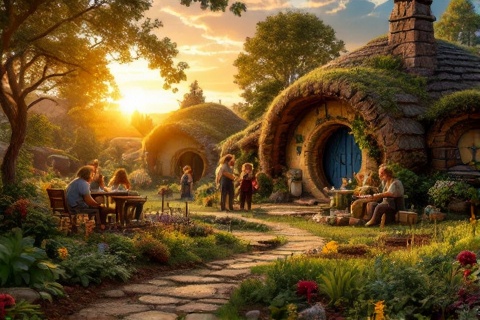
The physical rebuilding of the Shire began immediately after the Battle of
Bywater and continued throughout 3020 of the Third Age. Homes and businesses
that had been damaged or destroyed during Sharkey's regime were reconstructed,
often with improvements that maintained hobbit traditions while incorporating
new knowledge gained from the returning travelers. The restoration efforts
brought the community together in a shared purpose of renewal.
The emotional recovery of the hobbit community proved to be as important as the
physical rebuilding. The experience of occupation and resistance had left its
mark on the traditionally carefree hobbits, but their natural resilience helped
them process and move beyond the trauma. The shared experience of defending
their homeland and rebuilding their community strengthened the bonds between
families and neighborhoods.
Gradually, the Shire returned to its peaceful way of life, though changed in
subtle ways by its experiences. The gardens bloomed again, the fields produced
abundant crops, and the sound of singing and laughter returned to hobbit homes.
While maintaining their newfound awareness and readiness, the hobbits
successfully reclaimed the essential joy and contentment that had always
characterized their society.
Historical Significance
The Scouring of the Shire represented the last major conflict of the War of the
Ring, bringing the struggle against Sauron's influence to its final conclusion
in the very homeland of those who had played such a crucial role in his defeat.
This epilogue to the greater war demonstrated that even the most peaceful
corners of Middle-earth had been touched by the conflict, and that victory
required vigilance until the very end.
The events of the Scouring revealed the remarkable growth and courage of the
hobbits, particularly the four travelers who had returned from their great
journey. The transformation of Merry, Pippin, Sam, and Frodo from ordinary
hobbits into leaders capable of inspiring and organizing their people
demonstrated how their experiences had prepared them for this final challenge.
Their actions proved that the greatest heroes often come from the most
unexpected places.
The defeat of Saruman in the Shire symbolized the final victory over evil in
Middle-earth at the end of the Third Age. The fallen wizard's death at the hands
of his own servant, followed by the restoration of the Shire to its former
beauty and peace, marked the true conclusion of the age-long struggle against
darkness. The hobbits' victory demonstrated that the defeat of evil required not
just military might, but also the courage to defend one's home and the wisdom to
show mercy even to defeated enemies.
